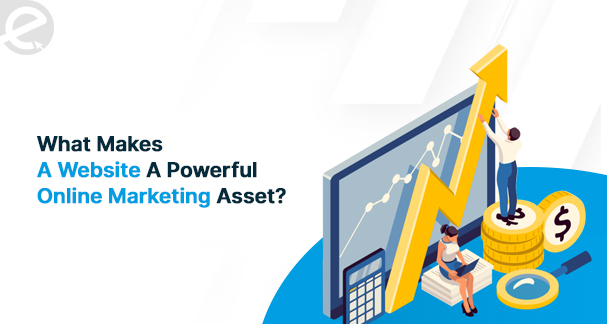
We Develop Websites Keeping Marketing in Mind
Steps To Create eCommerce Checkout Flow To Increase Conversions
 Jan. 23, 2023, 2:46 PM
Jan. 23, 2023, 2:46 PM- By Eclick Softwares and Solutions

In an eCommerce checkout flow process, the shoppers have to move through the steps starting from product pages to finalizing the purchase. Hence, the final touch to the online purchase process ends with the business making sales and customers confirmed with the delivery date. During the checkout process, visitors have converted into buyers and the product ownership shifts to the buyers from the sellers.
Now, to complete the checkout flow, the prospects have to follow a series of steps to complete payment for their chosen products.
All the Major Steps Involved in A Smooth eCommerce Checkout Flow
“Add to Cart" or "Buy Now" are the starting of the checkout flow. After payment and the "Thank You" Page mark the end. Being an aspiring motivated eCommerce business owner, you have to design each of these steps so the buyers experience a seamless purchasing journey and are convinced to further purchases.
In the checkout flow process, two things are targeted –
1. Obtaining customer information like the name, email, contact number, shipping address, gender, age etc. to run personalized ads, promotional outreaches and convenient future orders.
2. Collecting the customers’ payment information once they have paid.
The eCommerce checkout flows ideally involve –
i. Pre-Checkout Process
The pre-checkouts stage is the decision-making stage on the product page. Here the customers should be encouraged. So, supply all the vital information they need so they can make up their mind to buy soon.
ii. Add To Cart
As the potential buyers keep on adding products to the cart it makes clear they have buying intentions for the chosen products.
iii. Billing Information
Here, the customers receive an organized published receipt with information covering the product name, number of products, cost, and shipping address together with the total amount that involves the delivery charges (if any). The purpose here is to maintain both sides' transparency.
iv. Shipping Information
Here, the buyers provide information like the shipping address, shipping category, timing package and more. Sellers use the information for delivery purposes.
v. Shopping Method
In this step, the buyers select the payment mode – whether internet banking, online payment, online wallets (as in PayTM and Amazon Pay), or cash on delivery. They decide on their convenience after finding the options on the website.
vi. Secure Payment
Buyers choosing the online transaction mode undergo this stage. Their payment transfers the products' total cost value to the sellers by using the payment gateways. To complete payment, they have to add their card details, confirm OTP verification for purchase and then click on "Pay Now ".
vii. Confirmation
This step is for taking the buyers' final consent for payment. The confirmation is most necessary since the customers should not think otherwise. Customers should be ready to pay, not forced to pay.
viii. Thank You Page
Checkout flow finalizes with the "Thank You" page. It is good practice as it states the firm confirmation of the purchase confirmation to the buyers. The Page reflects the sellers' gratitude to customers for buying from them. So, it can be viewed as the personal bonding in the professional takeover.
Â
How To Set Up eCommerce Checkout Flow For the Customers To Easily Order and Pay?
Optimizing the entire checkout flow is the trick to encourage the customers from falling back into the eCommerce sales cycles at the time of checkout. These are the six best practices for checkout flow for the eCommerce storefront.
1. Guest Login and Registration Options – Both Are Necessary
A one-time registered customer account is enough. For the new customers, let them have a guest checkout option. Later, they might be persuaded into an account creation, which will be their registered account. Next, to log in, they can only use their username and password.
2. Simplified Checkout Process
Easy navigation from one purchase stage to the next, without any interference. Customers will know the next step to take in the checkout flow when the purchase sequence is specific and contains clear visual indicators. Likewise, they can decide and complete the purchase. Keeping the purchase sequence simplified by having only the needed form fields in the checkout process.
After the customers have successfully added their needed products to the cart and they are ready to pay the sum total (after applying the coupon code, if available) – all they need is a secure checkout page where they will only have to enter the needed shipping and billing details on the simplified order form.
Whatever they fill, they should fill just once – a check-off box should be provided for their approval to save their details for future reference. Customers prefer clear and accessible checkout buttons on the shopping page.
3. Adding Trust Seals Helps In Increasing Credibility
Customers would never want to handle the security concerns like fraud or data theft after furnishing sensitive information on your eCommerce site, which are their card details and shipping information. So, keep the trust seals displayed on the checkout page to address all such security concerns and increase customers' confidence in data protection. These are the trust seals the customers look for –
Payment Trust Seals – Trusted methods of Visa, PayPal and MasterCard.
Security Trust Seals – Norton and VeriSign with safe checkout seals ensure the complete checkout and financial data are secured.
Money-Back Guarantee Seals – Affirming money refunds after an item is returned.
Third-Party Endorsement Seals – The business is well-established and endorsed by a group of experts. The third–party has to approve the endorsement seals. Related other recognized trust seals are TrustedSite, Google Customer Review, Amazon Best Seller and Better Business Bureau.
4. Varied Shipping Options Available
Fast and convenient shipping as well as delivery options catering to every possible situation are the ingress to building customer loyalty. These are the shipping fee options to implement –
a. Table Rate Shipping – Shipping rates are fixed according to the customers' locations, item size and product weight.
b. Flat Rate Shipping – Multi-ship functionality is the name here. Products can be shipped to multiple addresses – customers can place a large order and at checkout, split it.
c. Order Value Free Shipping – Free shipping is available only when customers purchase goods worth your stated amount.
d. Seasonal Free Shipping Coupons – Free shipping coupons are available during the festive seasons.
e. Local Pickup – Customers within the store's vicinity can choose the closest hub or store to pick up the orders at their convenience.
5. Emphasizing On Payment Security
Buyers will pay online only when they are sure the payment page is perfectly safe and secure. Keep the payment gateway's original brand logo so the buyers are confident. Use terms like "Secure Pay" in the click bar that reminds the customers of secured payment.
6. Retargeting the Abandoned Carts
Now it's time to find a remedy to the abandoned carts – the quick solution to it is offering incentives in the form of discounts. Sending cart abandonment reminder emails with the discounts and coupons mentioned influences the customers to complete their purchases.
Emails should have an emergency to establish the needed emotional connection with potential customers.
A well-designed checkout flow leads you to win the game at the end. While selling products, you are even creating customer experiences that will increase conversion. Indeed eCommerce checkout flow needs legwork – but it is worth time for the present and future.
Â
Â
Related Blog
- By Eclick Softwares and Solutions
- November 21, 2024
Why Good UX Design Mean B ...
UX creates a verified impact on CRO for a website. The users ...
Read More- By Eclick Softwares and Solutions
- November 11, 2024
How Important is a Websit ...
Where the customers land and browse to find their needed pro ...
Read MoreSearch Blog...
Recent Posts
Eclick Services







